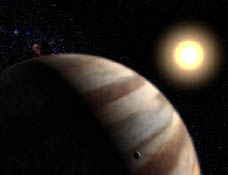
Using the Hubble Space Telescope, astronomers have detected their first chemical element in the atmosphere of a planet outside the solar system. This artist's conception shows a Jupiterlike planet closely orbiting the star HD 209458.
Courtesy G. Bacon (STScI/AVL).
In the past six years, astronomers have found nearly 80
gas-giant planets orbiting stars beyond our solar system. Although the
discoveries keep piling up, researchers could only theorize about exactly
what these worlds are made of, or what they look like. But that has
started to change.
Yesterday a team of astronomers using the Hubble
Space Telescope announced that they have detected the atmosphere
of the one known extrasolar planet that crosses directly in front of
the face of its star. They even suggested — very tentatively —
that it has a high layer of clouds. The team was led by David Charbonneau
(Caltech) and Timothy Brown (National Center for Atmospheric Research);
their report will be published in the Astrophysical Journal.
Charbonneau and Brown's team analyzed high-resolution
spectra of HD 209458 — a 7.7-magnitude Sunlike star 150 light-years
away in Pegasus — with and without the planet in front of it. Using
the telescope's spectrograph to split the starlight into its constituent
colors, they detected a tiny trace of extra sodium absorption when the
planet was silhouetted on the star's face. The implication is that starlight
grazing the edge of the planet was filtered by sodium in its atmosphere.
The effect was miniscule — the change in the star's
spectrum amounted to only one part in 5,000. According to Brown, the
most interesting result is that "it simply proves it's possible to detect
a spectral feature in an exoplanet."
The astronomers chose to look for sodium because it has
an extremely strong spectral signature. The sodium actually amounts
to just a few parts per million in the planetary atmosphere. In fact,
the amount detected was only half that expected from atmospheric models
based on Jupiter. The deficiency might be caused by high clouds of dust
in the planet's hot atmosphere blocking some of the light passing through.
Or perhaps some sodium has become undetectable because of chemical reactions
with other substances.
With this result, "we have entered into a new phase in
the era of extrasolar planet discovery and characterization," says Alan
Boss (Carnegie Institution of Washington). Charbonneau hopes to detect
and analyze light reflected by other extrasolar planets that don't transit
their stars. Eventually astronomers hope to measure methane, water,
and possibly oxygen and ozone in exoplanetary atmospheres.
 0
0
Comments
You must be logged in to post a comment.